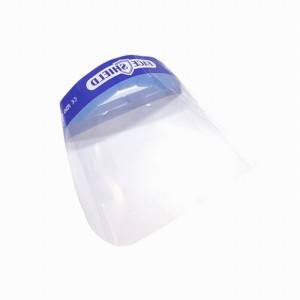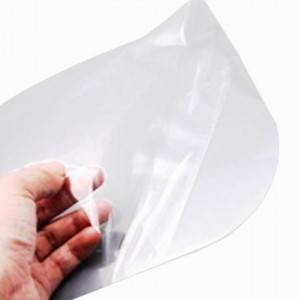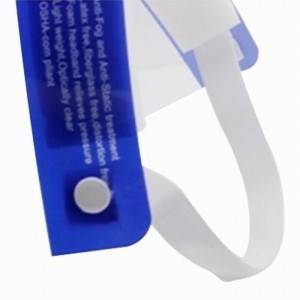Protective Face Shield
Features and benefits
Technical Details & Additional Information
| Code | Size | Specification | Packing |
| PFS300 | 330X200mm | PET material, Transparent face shield visor, with wide elastic band | 1 pcs/bag, 200 bags/carton (1x200) |
Why are face shields worn during patient care?
Protection from splashes and sprays: Face shields provide a physical barrier that helps protect the wearer’s face from splashes, sprays, and droplets, particularly during medical procedures or when working in close proximity to patients.
Preventing contamination: They help prevent contamination of the face and eyes from bodily fluids, blood, or other potentially infectious materials, reducing the risk of exposure to pathogens.
Eye protection: Face shields offer additional protection for the eyes, which are vulnerable to exposure to infectious agents. They can be particularly important in situations where there is a risk of airborne particles or droplets.
Comfort and visibility: Face shields are often more comfortable to wear for extended periods compared to goggles or safety glasses. They also provide a clear field of vision, allowing healthcare workers to maintain visual contact with patients and colleagues.
Overall, wearing face shields during patient care helps to ensure the safety and well-being of healthcare workers and reduces the risk of exposure to infectious agents.
What is a full face visor in medicine?
A full face visor in medicine is a protective equipment that covers the entire face, including the eyes, nose, and mouth. It typically consists of a transparent visor that provides a clear field of vision while offering protection against splashes, sprays, and airborne particles. Full face visors are commonly used in medical settings to provide comprehensive facial protection for healthcare workers during various procedures, particularly those involving a risk of exposure to bodily fluids, blood, or infectious agents. They are an important component of personal protective equipment (PPE) and play a crucial role in ensuring the safety and well-being of healthcare professionals while caring for patients.
What is the difference between a face mask and a face shield?
Coverage: A face mask primarily covers the nose and mouth, providing a barrier for respiratory droplets. In contrast, a face shield covers the entire face, including the eyes, nose, and mouth, offering protection against splashes, sprays, and airborne particles.
Protection: Face masks are designed to filter and reduce the transmission of respiratory droplets, providing protection for the wearer and those around them. Face shields, on the other hand, primarily act as a physical barrier to protect the face and eyes from splashes, sprays, and other potential sources of contamination.
Reusability: Many face masks are designed for single or limited use and may need to be disposed of after each use. Some face shields are reusable and can be cleaned and disinfected for multiple uses, making them more sustainable in certain situations.
Comfort and Communication: Face masks can affect communication and may be less comfortable for extended wear, while face shields offer a clear field of vision and can be more comfortable to wear for longer periods. Additionally, face shields allow for facial expressions to be visible, which can be important for effective communication, especially in healthcare settings.
Both face masks and face shields play important roles in infection control and personal protection, and their effectiveness can be enhanced when used together as part of a comprehensive approach to safety in healthcare and other settings.
How effective are face shields?
Face shields are effective in providing a physical barrier against splashes, sprays, and airborne particles, which can help protect the face, eyes, nose, and mouth from potential contamination. They are particularly useful in situations where there is a risk of exposure to bodily fluids, blood, or infectious agents. While face shields alone may not provide the same level of filtration as face masks, they offer valuable protection against larger respiratory droplets and can be an important component of personal protective equipment (PPE) in healthcare and other settings.
When used in conjunction with other preventive measures, such as face masks and physical distancing, face shields can contribute to a comprehensive approach to infection control. Additionally, face shields can be particularly beneficial for healthcare workers who may be in close contact with patients or performing procedures where there is a higher risk of exposure to potentially infectious materials. It’s important to note that the effectiveness of face shields can be influenced by factors such as proper fit, coverage, and adherence to recommended usage guidelines.
When should Face Shield be worn?
Healthcare settings: In medical facilities, protective face shields should be worn by healthcare workers during procedures that may involve exposure to bodily fluids, blood, or other potentially infectious materials. They are particularly important when performing aerosol-generating procedures or when working in close proximity to patients.
Close-contact care: When providing care for individuals who are unable to wear face masks, such as those with certain medical conditions, face shields can offer an added layer of protection for both the caregiver and the person receiving care.
High-risk environments: In settings where there is a higher risk of exposure to respiratory droplets or splashes, such as crowded public spaces or environments with limited ventilation, wearing protective face shields can help reduce the risk of contamination.
Personal preference: Individuals may choose to wear protective face shields in addition to face masks for personal comfort or as an extra precaution, especially in situations where maintaining physical distance is challenging.








